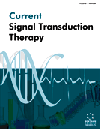- Home
- A-Z Publications
- Current Signal Transduction Therapy
- Previous Issues
- Volume 8, Issue 2, 2013
Current Signal Transduction Therapy - Volume 8, Issue 2, 2013
Volume 8, Issue 2, 2013
-
-
Class II Phosphoinositide 3-Kinases as Potential Novel Drug Targets
More LessAuthors: Alexandre Arcaro, Anna Borgstrom and Karolina BlajeckaPhosphoinositide 3-kinases (PI3Ks) play an essential role in the intracellular signal transduction cascades initiated by the activation of cell surface receptors through their specific extracellular signals. PI3Ks control a variety of cellular responses, including growth, protection from apoptosis, motility, metabolism and intracellular protein sorting. Eight catalytic PI3K isoforms exist in human, which are grouped into three classes Read More
-
-
-
Brefeldin A Inhibits Cancer Stem Cell Properties in Human Lung Cancer Cells
More LessBrefeldin A (BFA) is an fungal antibiotic that induces ER stress in eukaryotic cells. Cancer stem cells (CSCs) have indefinite potential for self-renewal and the capability to drive tumorigenesis. The effects of BFA on CSCs have not been fully investigated. In this article we investigated the inhibitory effects of BFA on human lung cancer A549 and H1299 cells. Cytotoxicity toward suspension cultures has been used as a method for the Read More
-
-
-
Differential Adaptive Changes in Dopaminergic System by Acute vs. Subchronic Ketamine: Relevance for Psychosis Pathophysiology and Treatment
More LessThe NMDA receptor non-competitive antagonist ketamine is regarded to model multiple symptomatic domains and molecular dysfunctions of schizophrenia, depending on acute or chronic exposure to the drug. In this work, we aimed to investigate whether ketamine may induce changes in the expression of transcripts relevant for the dopaminergic system (i.e. dopamine D1, D1R, and D2 receptors, D2R, dopamine transport Read More
-
-
-
Transmembrane Phosphatases and Cancer Development, the Role of Protein Tyrosine Phosphatase-kappa (PTPκ) and Protein Tyrosine Phosphatase-mu (PTPμ)
More LessAuthors: Ping-Hui Sun, Lin Ye, Malcolm D D. Mason and Wen G. JiangProtein tyrosine phosphatases (PTPs) are important in the regulation of diverse cellular functions including proliferation, migration and invasion; aberration of these cellular events is crucial for the development and progression of cancer. PTPs family comprises of two groups, classic PTPs and dual specificity phosphatases. The classic PTPs include both non-transmembrane PTPs and transmembrane receptor-like PTPs (RPTPs). Read More
-
-
-
Electric cable: cytoskeleton as an electric transmitter for cancer therapy
More LessAuthors: Deyou Xiao, Chenguo Yao, Chengxiang Li and Liling TangCytoskeleton is a major component of living cells consisting of microfilaments, microtubules and intermediate filaments. It plays a key role in many cell functions such as cell migration, cell division, signal transduction and cell apoptosis. Researchers have investigated the cytoskeleton by analyzing its molecular components in isolation and studying its ‘gel’ properties. The proposal of tensegrity model firstly considers the cy Read More
-
-
-
Investigation of the Antiproliferative Action of the Quinoline Alkaloids Kokusaginine and Skimmianine on Human Cell Lines
More LessAuthors: Judit Molnar, Imre Ocsovszki, Laszlo Puskas, Tannaz Ghane, Judit Hohmann and István ZupkoNatural products play a crucial role in research into innovative antiproliferative agents. More than 60% of anticancer drugs involve compounds of natural origin. The aim of the present study was to determine the cytotoxicity effects of 11 quinoline alkaloids isolated from plants of the Rutaceae family. The MTT assay was used to identify the antiproliferative effects of the tested compounds on human adherent cancer cell lines (H Read More
-
-
-
Homology-Based Design for Selective GSK-3 Peptide Inhibitors: Patent Applications and Type 2 Diabetes Mellitus
More LessProtein kinases function in key steps in several physiopathological events; therefore the development of specific inhibitors to these enzymes presents new opportunities for the treatment of various diseases. Glycogen synthase kinase 3 (GSK-3) is a constitutively active serine/threonine kinase, whose dysfunction has been linked to several cases of insulin-resistant type 2 diabetes mellitus, Alzheimer’s disease and mood di Read More
-
-
-
Qi-Shao-Shuang-Gan Prevents Adhesion between Leukocytes and Inflammatory Endothelial Cells
More LessAuthors: Xinghua Gao, Difei Bian, Xianxiang Xu, Rong Pan, Yufeng Xia, Side Jiang and Yue DaiOur previous studies demonstrated that Qi-Shao-Shuang-Gan (QSSG), a combination of Astragalus membranaceus saponins (SAM) with Paeonia lactiflora glycosides (GPL), possessed protective effects against sepsis in mice. The present study aimed to explore its underlying mechanisms with a focus on the adhesion between leukocytes and inflammatory endothelial cells. Our results showed that QSSG (10, 30, 100 μg/ml) conc Read More
-
-
-
The Senescent Mesenchymal Stem Cells in Systemic Lupus Erythematosus
More LessAuthors: Guijuan Feng, Wei Tan and Zhifeng GuCurrent studies have found that allogenic mesenchymal stem cells (MSCs) transplantation (MSCT) can be used successfully in mouse and human SLE. However, syngeneic bone marrow (BM)-MSCT was ineffective. Recently, studies also revealed that BM-MSCs from SLE patients showed senescent behavior. These findings suggested that the senescence of BM-MSCs from SLE patients may be a contributing factor to diseas Read More
-
Volumes & issues
-
Volume 20 (2025)
-
Volume 19 (2024)
-
Volume 18 (2023)
-
Volume 17 (2022)
-
Volume 16 (2021)
-
Volume 15 (2020)
-
Volume 14 (2019)
-
Volume 13 (2018)
-
Volume 12 (2017)
-
Volume 11 (2016)
-
Volume 10 (2015)
-
Volume 9 (2014)
-
Volume 8 (2013)
-
Volume 7 (2012)
-
Volume 6 (2011)
-
Volume 5 (2010)
-
Volume 4 (2009)
-
Volume 3 (2008)
-
Volume 2 (2007)
-
Volume 1 (2006)
Most Read This Month
Article
content/journals/cst
Journal
10
5
false
en


